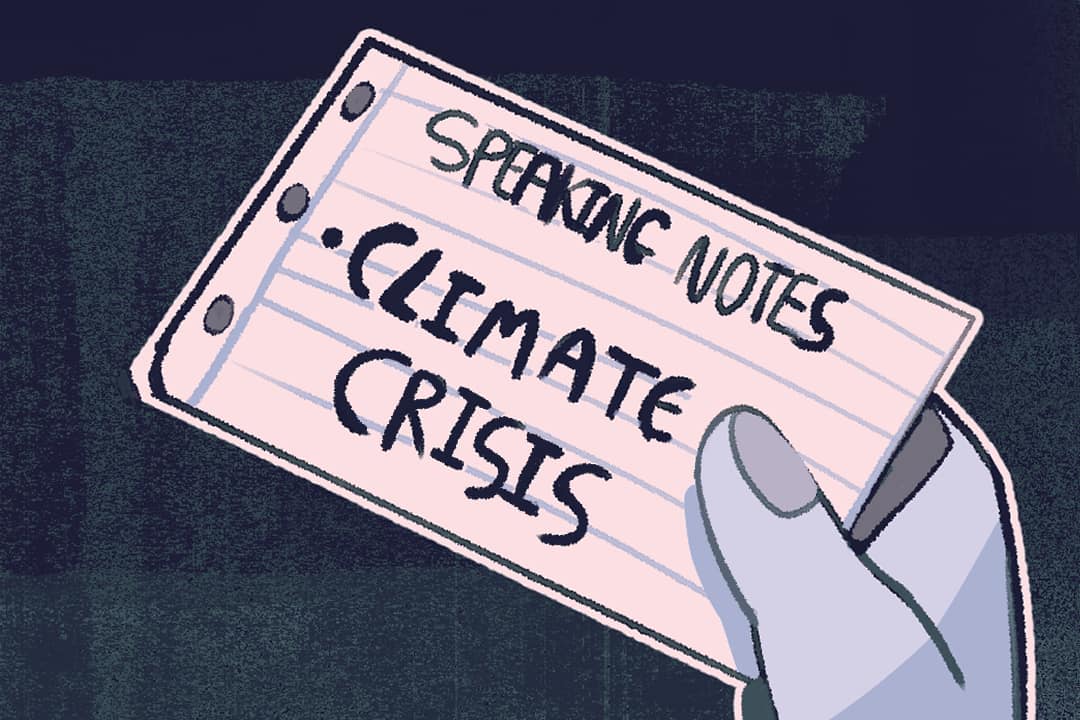On October 20, the 13th day of Israel’s bombardment of the Gaza strip following the Hamas attack on October 7, prominent Swedish climate activist Greta Thunberg posted a picture of herself with some friends on social media platform X. They were holding signs that read “Free Palestine,” “Stand with Gaza,” and “Climate Justice Now.” In the caption of the picture, Thunberg expressed the importance of calling for “an immediate ceasefire” and “justice and freedom for all Palestinians and civilians affected.”
The Government of Israel’s official account on X, managed by the country’s Ministry of Foreign Affairs, replied to Thunberg’s post, writing, “Hamas doesn’t use sustainable materials for their rockets which have BUTCHERED innocent Israelis. The victims of the Hamas massacre could have been your friends. Speak up.”
In my view, the Israeli government’s response on social media is littered with hypocrisy, as the last 50 days of its bombardment of the Gaza strip — and its recent business operations — have revealed that it seems to have very little regard for climate protection.
Violations of international law aren’t very environmentally friendly
Human Rights Watch has verified videos taken in Gaza and Lebanon in early October that show Israeli military operations using artillery-fired white phosphorus. The Israel Defence Forces (IDF) also used white phosphorous in its bombardment of Gaza from December 2007 to January 2008. Using white phosphorous — especially in densely populated areas like the Gaza Strip — is illegal under international law because it is classified as an incendiary weapon under Protocol III of the Convention on Conventional Weapons.
When exposed to oxygen, white phosphorous ignites, and the resulting fires and thick smoke can be extremely harmful. As such, the US Environmental Protection Agency has listed white phosphorous as a Hazardous Air Pollutant. The Agency for Toxic Substances and Disease Registry under the US Department of Health and Human Services has also listed multiple more long-term potential environmental harms from its use, such as the contaminated water and a buildup of white phosphorous in fish, soil, and sediments.
These harms from white phosphorous come on top of the struggles Palestinians have already been facing through fishing limitations and limited access to clean water as a result of Israel’s 16-year-long blockade of the Gaza Strip — and I believe they will have devastating and long-lasting impacts on Gaza’s population.
Destroying farmland isn’t sustainable either
According to Al Jazeera, the IDF targets farmlands in Gaza with bombing during times of war in an ongoing pattern; in 2014, Israel’s 51-day bombardment of the Gaza Strip destroyed 17, 000 hectares of farmland. The IDF has also been documented spraying farmland with pesticides since 2014, killing crops and making land unsuitable for agriculture. At the same time, there is documentation of Israeli settlers setting fire to farmlands and preventing Palestinians from accessing their olive groves for harvest with violence in the occupied West Bank.
The violence has increased in frequency since the October 7 attack. On October 28, olive farmer Bilal Saleh was shot and killed by an Israeli settler as he was harvesting from his grove in al-Sawiya, a village near the city of Nablus in the occupied West Bank.
In 2020, U.N. Middle East envoy Nickolay Mladenov told the UN Security Council, “Each year, the ability of Palestinians to harvest is compromised due to access restrictions, attacks and intimidation.”
One important aspect of Palestinian agriculture is the olive harvest. Olive groves account for 48 per cent of Palestine’s agricultural land and fuel 14 per cent of its economy, and they carry cultural and historical significance for Palestinian families who have been harvesting for generations.
The destruction of olive trees also carries serious implications for sustainable agriculture and the Palestinian economy, not to mention the serious environmental harm from destroying acres of farmland and trees. Some of these harms include reduced carbon dioxide absorption, soil erosion, and food insecurity for Palestinians.
What’s hiding behind the green shield?
The Israeli government’s hypocrisy on social media in pointing out Hamas’ use of unsustainable materials to gain public support has been described as “greenwashing” by organizations such as the US Campaign for Palestinian Rights. Greenwashing is a form of advertising where an entity spends more time marketing environmentally friendly aims instead of carrying out environmentally friendly practices. This is often done by companies or governments in an attempt to distance themselves from their neglectful practices.
In the case of the Israeli government, along with the environmental harm it has been causing against Palestinians, its economic ventures suggest to me that its front of sustainability is a farce.
Amid the ongoing violence, Israel’s Energy Ministry announced on October 29 that it had given licenses to six companies to search for natural gas reserves off the Mediterranean coast. This is especially alarming after an Israeli wartime document drafted on October 13 showed plans to transfer the Gaza Strip’s entire population of 2.3 million people into the Sinai Peninsula in Egypt, as well as other countries in the Middle East. According to Basav Sen, climate policy project director at the Institute for Policy Studies, “The Israeli occupation that we’re seeing is a manifestation of the same process of colonialism that has also brought us the climate crisis.” Just as violent European colonization disrupted sustainable connections with the land for Indigenous people in Canada, I see the Israeli occupation’s violence in Palestine carrying serious implications for the environment and pointing to an even more sinister objective: the expulsion of the population for access to fossil fuels.
What I see as the Israeli government’s false concern for the climate crisis — displayed during what United Nations experts have called “a genocide in the making” — would be laughable only if it wasn’t so grave.
Urooba Shaikh is a third-year student at UTSC studying molecular biology, immunology, and disease. She is a Climate Crisis Columnist for The Varsity’sComment section.



No comments to display.